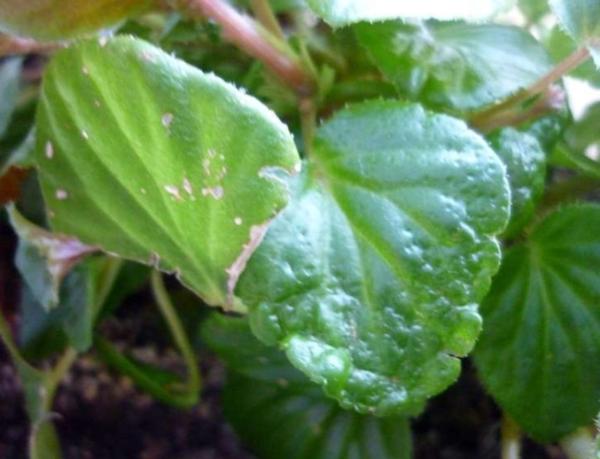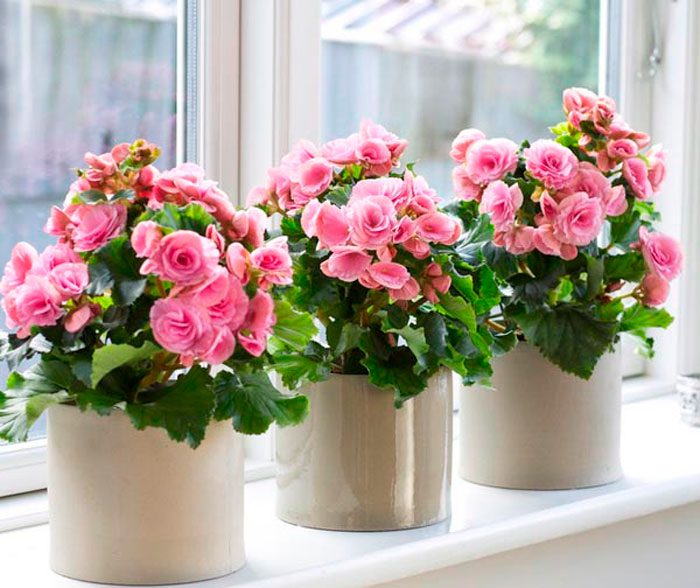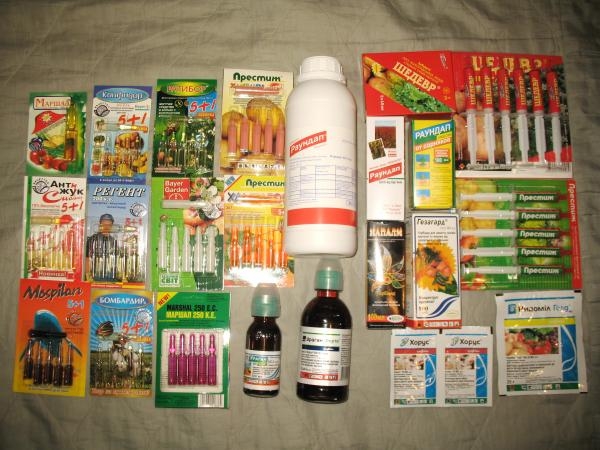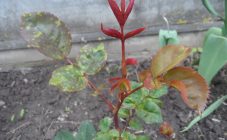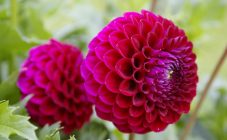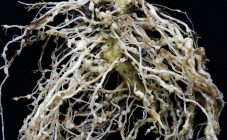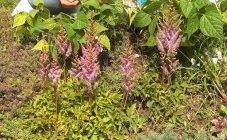Content:
This common flower requires attention and proper care. Begonia diseases are often the result of growing errors. Unsightly appearance, dry foliage make you look for solutions to problems.
Signs of illness and possible causes
Begonia can get sick if it gets infected from other plants. The reason may be poorly prepared soil, pot and working tools that have not been disinfected. Probable causes of problems are care errors.
Why do begonia leaves curl and dry at the edges?
Maybe:
- the air is too dry;
- weak watering;
- stands on a brightly lit windowsill.
As summer approaches, when the activity of the sun increases, the leaves on the lower side acquire a reddish tint. This should not be a cause for concern. When the entire leaf plate turns red, then this is already excessive lighting.
It is worth eliminating the factors present in order to revive the begonia:
- humidify the air from the spray bottle;
- install containers with water next to them;
- carry out regular watering;
- move the pot to a less lit place.
Due to intense watering and cool air, the leaves turn yellow and fall off, the begonia stops blooming. First aid is moving to a warmer place and refusing to water for a while.
If the newly appearing leaves are small, or the begonia stops blooming and growing, then this is a sign of insufficient nutrition. The flower needs feeding, and the best option is liquid fertilizer for flowering houseplants. Will give an effect and transplant.
Why do tuberous begonia flowers fall? Reasons for the phenomenon:
- lack of nutrition;
- too dry air;
- excess moisture in the ground.
The flower withers, the leaves are sluggish, unattractive - this happens when begonia is kept in the kitchen with a gas stove, it is negatively affected by combustion products. To reanimate, the pot is placed in another place with regular ventilation.
In winter, they begin to lose color and leaves fall off. The flower sheds its foliage due to the low temperature in the room or cold wind from the window from the street. It is enough to create a more comfortable temperature and eliminate the penetration of cold.
The appearance of rot indicates frequent spraying of the plant, which the flower does not tolerate. Water only the soil, avoiding excess water, or decay will begin.
Begonia needs special attention during flowering: diffused sunlight, watering and nutrition.
Common diseases
Gray rot (mold) caused by excessive watering and high humidity. First, sticky light gray spots appear on the leaves, the upper part of the shoots and on the inflorescences, darkening after a while, changing color to brown. Rotten stems fall off, holes form on the leaves.
To reanimate, the plant is transferred to a dry place, all spoiled is removed. The remaining parts are treated with solutions:
- 0.1% euparene;
- 0.1% foundation;
- 1% bordeaux liquid;
- 2 g of copper sulfate, 20 g of soap per 1 liter of water.
When the growth stops, the flower wilts, it can be transplanted, but if blackening and decay of the roots is noticed, then these are characteristic signs of black root rot. The drug benomyl treats rot, it is sprayed with a diseased plant. To avoid the return of infection, switch to moderate watering.
Why do begonias drop buds? Bacterial wilting, which is characterized by black spots on the flowering plant, may be the cause. Bubble spots on the leaves grow and turn black. Rescue in spraying with a systemic fungicide.
Vascular bacteriosis is expressed in the yellow color of the edge and tips of the leaves, then it changes to brown. The center of the leaf plate is green, and the vessels turn black. Diseased leaves are cut off, healthy ones are treated with fungicides.
You should choose complex drugs with high efficiency:
- foundation;
- phytosporin-M;
- copper sulfate;
- topaz;
- bordeaux liquid.
Methods of dealing with mpowdery mildew
More often, the aerial part of begonia suffers from powdery mildew. The leaves are covered with light spots with a whitish bloom. They quickly grab leaf blades and stems. Over time, the leaves turn brown, dry out and die off. What to do if begonia has a white bloom? The diseased flower must be isolated.
Treatment with fungicides for indoor plants will stop the development of the disease. When the spots have just appeared, it is enough to spray the foliage with alirin-B or phytosporin-M. For a more serious problem, when all the leaves are affected, they are treated with strobin or topaz.
Solutions will help cure powdery mildew on begonia:
- 0.05% morestan;
- 0.05-1% of foundation;
- 2 g of copper sulfate + 20 g of green (tar) soap per 1 liter of water.
The preparations are sprayed on the affected flower.
Refractory begonia diseases
There are diseases, the treatment of which does not give results, the flower disappears. It is better to remove the affected plant so that the infection does not spread further.
Ring spot - a virus that lives in cells, it is difficult to get rid of it, since it persists in the tubers, and after a while it appears again. Light green-yellow spots and strokes appear on the leaves, which turn into bronze, dead areas appear. Blooming begonia flowers turn black. The only way out is to destroy the diseased plant.
Bacterial spotting is manifested by the appearance on the underside of the leaves of small watery specks, which eventually darken, acquire a brown tint and spread to the entire begonia.
The flower must be destroyed, the pots and soil must be disinfected.
Prevention: treatment 2 times with a 0.5% suspension of copper oxychloride at intervals of half a month.
Cucumber mosaic is a virus that causes the leaves to become covered with ring-shaped and round yellow spots, followed by their deformation. There is no way to get rid of the disease. The virus spreads very quickly, actively capturing the entire flower. Having discovered, the source of infection is immediately eliminated.
Pests and the fight against them
Insects, carriers of infections, annoy begonias.
| Insect name | Description | Visible manifestations and harm done | Methods and means of struggle |
|---|---|---|---|
| Greenhouse whitefly | A carrier of viral infections up to 1.5 mm long with large white wings. The female lays eggs on the underside of the leaf. | The appearance of blurry whitish, yellowish spots; plant juice - food for larvae, moths eat the fleshy part; the leaves are deformed, curled, discolored, dry out; waste products - a habitat for fungi. | Spraying with soapy water, in which it is necessary to avoid getting liquid on the roots. |
| Gall nematode | The worm is 1.2 mm long, lives in the lower aboveground and underground parts of the plant. | Outgrowths and swellings are formed, larvae grow in them; growth slows down; larvae and worms attack the plant: it rots, shoots, buds fall off; the flower dies. | Prevention - pre-planting soil treatment with steam; watering with 1% formalin or thiazone solution. For treatment, remove the damaged parts; water at the root with 0.05-0.2% heterophos solution. |
| Soft shield | Sugar discharge with a dark bloom and fungi; insect up to 4 mm in size, the body of the female is covered with waxy shields of yellow-brown color, has piercing and sucking feeding organs, is motionless; larvae move until they attach to the plant. | The pest eats juices; begonia quickly discolors, loses strength, deforms, dries up and dies. | Remove mechanically using a brush; sprayed with: infusion of garlic or pyrethrum (10 g per 1 liter of water), treatment after infection is carried out every 2-3 weeks; pesticide according to the instructions with a mandatory repetition of the procedure. |
| Red spider mite | A thin web is a sign of presence, this is facilitated by warm conditions of detention and excess water. | The leaves take on the shape of marble, become covered with cobwebs, turn yellow and fall off. | Spray the affected plants with decis, especially the underside of the leaves. |
| Greenhouse aphid | Insect green or yellow up to 2.5 mm long without wings with sucking-piercing organs for feeding. Adults and larvae bring harm. | It sucks out juices, leaves turn yellow and curl, falling begins; buds do not bloom, inflorescences fall off. With a massive defeat, the plant dies. | At home, processing: soapy water; tobacco infusion; actellic or fufanon preparations. |
| Greenhouse thrips | With two pairs of wings, 1.5 mm long with piercing-sucking mouth organs. The adult is dark brown, the larva is light. Hibernates on roots. | Appearance - discoloration, yellowing of leaves, stunted growth, ugly inflorescences. | Spray: soapy water; infusion of tobacco. Prevention: before planting treatment of tubers with karbofos - 20 g per 10 liters of water. |
A leaf nematode can still hit a flower. It is a 1 mm long worm that kills the top of the plant. Its appearance is signaled by light green spots on the leaves, gradually turning into brown ones, the shoots thicken, bend. The struggle does not bring success, the begonia is removed, the pot is disinfected. But at an early stage, the drug heterophos can help, with a 0.05-0.2% solution of which the plant is sprayed.
How to save a dying begonia
From care errors, the suffering begonia can sometimes be revived by reviving a dying flower.
- Begonia leaves dry at the edges, what should I do? This can happen in winter due to dry air in the apartment. To save a flower, you need to add wet pebbles to the pan, put water nearby.
- Buds and flowers are showered. Partial pruning of shoots and transplanting into new soil will help to cope with this.
- Sometimes it is possible to reanimate a begonia with a completely bare stem and dry leaves, but provided that the root is still alive. You can prune the stems and leaves, leaving the lower internode, and transplant into new soil. Cover the pot with a bag. Spray with epin once a week until new leaves appear.
A healthy begonia pleases the owner, affected by a disease or insects, makes you think about how to help your pet.Knowledge of the rules for care and ways to solve the problems that have arisen will help to protect from the invasion of pests, diseases.
